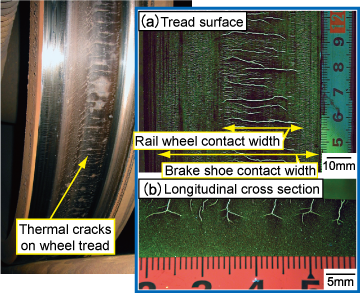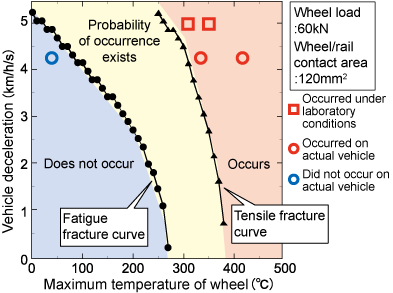1. Method for determining the presence of and gaining insight into the cause of wheel tread thermal cracking
- It is nowadays possible to reproduce heat cracking on real wheel surface treads on a test bench.
- After gaining more insight into the causes of wheel tread heat cracking, a graph can be drawn to determine the presence of absence of wheel tread thermal cracking using maximum wheel temperature and deceleration.
Wheel tread thermal cracking is a defect which appears on the tread of railway vehicle wheels on which tread braking is applied. When this type of cracking occurs, frequent reprofiling is required, shortening the wheel’s serviceable life. Tread surface observation however, during use is difficult, and up until now it has not been possible to reproduce examples of this type of crack on test benches and so the conditions under which cracking occurs remain unclear and no countermeasures have been established.
Through repeated application of thermal and contact loads onto the rail/wheel interface during tread braking, of a real wheel, researchers were finally successful in reproducing the same type of thermal cracking as observed in operation (Fig 1). After detailed investigation of the microstructure under the area displaying thermal cracking and of surface of the fracture, insight was gained about the temperature at time of cracking and crack progression characteristics. Subsequently the internal stress state was estimated through numerical analysis. This insight was employed to perform verification tests on an actual wheel in order to corroborate the thermal crack generation mechanism. It was confirmed that the two main causes for appearance and progression of thermal cracking were thermal stress (residual stress) produced by tread braking, and driving force (tangential force) on the wheel/rail interface.
Based on these results, decrease of the strength of the wheel steel in higher temperatures was considered, then, the limit conditions were calculated for tensile fracture and fatigue fracture. These elements were used to plot a graph assessing the risk of thermal crack development based on the determinants ‘wheel temperature’ and ‘vehicle deceleration’ (Fig 2).
Based on the above, it has now become possible, in the light of vehicle parameters to quantitatively evaluate the risk of thermal cracking developing on the tread. It should be possible to use the outcome of this work in improving brake shoes and optimising brake control, etc., and integrate these results into braking system design which has incorporated measures to prevent tread thermal cracking.
 Fig. 1 Thermal cracking on the tread surface of real wheel (left) tread surface thermal cracking reproduced through the tests (right)
Fig. 1 Thermal cracking on the tread surface of real wheel (left) tread surface thermal cracking reproduced through the tests (right) Fig. 2 Example of developed graph illustrating thermal cracking critical loading conditions developing on the tread surface
Fig. 2 Example of developed graph illustrating thermal cracking critical loading conditions developing on the tread surface